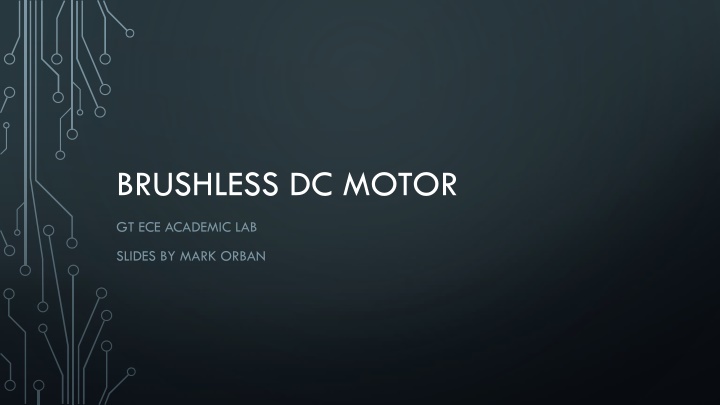BRUSHLESS DC MOTOR.
Brushless DC motors offer advantages such as smaller size, lighter weight, and controlled speed through electronic speed controllers. They come in outer rotor and inner rotor types, each with its own set of advantages and disadvantages. Brushless motors have three wires compared to two in brushed motors, generating less RF interference and eliminating constant arcing. Explore the differences and characteristics of brushless and brushed DC motors for a better understanding in academic labs.
Download Presentation

Please find below an Image/Link to download the presentation.
The content on the website is provided AS IS for your information and personal use only. It may not be sold, licensed, or shared on other websites without obtaining consent from the author.If you encounter any issues during the download, it is possible that the publisher has removed the file from their server.
You are allowed to download the files provided on this website for personal or commercial use, subject to the condition that they are used lawfully. All files are the property of their respective owners.
The content on the website is provided AS IS for your information and personal use only. It may not be sold, licensed, or shared on other websites without obtaining consent from the author.
E N D
Presentation Transcript
BRUSHLESS DC MOTOR GT ECE ACADEMIC LAB SLIDES BY MARK ORBAN
WHAT IS A BRUSHLESS MOTOR A synchronous motor using a switching power supply Controlled via an electronic speed controller (ESC) circuit Smaller and lighter than equivalent brushed DC motors
OUTER ROTOR TYPE Advantages: Easy to obtain large torque. Speed is stable during constant rotation. Disadvantages: The rotor is large (the motion is slow). The outside rotor requires appropriate safety measures. Source: https://www.nidec.com/en/technology/capability/brushless/
INNER ROTOR TYPE Advantages: The rotor is small and can respond quickly. The coil is located on the outside and the level of heat dissipation is high. Disadvantages: Difficult to obtain large torque. Magnets can be damaged by centrifugal force. Source: https://www.nidec.com/en/technology/capability/brushless/
BRUSHLESS VS BRUSHED Brushless has three wires vs two for brushed Brushless doesn't have the constant arcing of the brushed commutator Generates less RF interference than brushed DC motors























